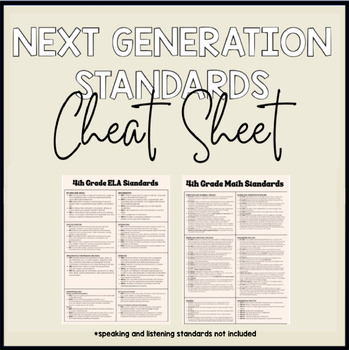4th Grade Next Generation ELA & Math Standards Cheat Sheet
- PDF
Description
This teacher cheat sheet provides a concise and organized overview of the 4th-grade generation standards for math and ELA, allowing teachers to have quick and easy access to key information. The cheat sheet is designed to fit on two pages for convenient reference.
The cheat sheet's layout is designed for easy navigation, allowing teachers to quickly locate specific standards they need to review or incorporate into their lesson plans. It serves as a valuable tool for planning instruction and ensuring alignment with the 4th-grade standards.
On the first page, you will find the ELA standards. The second page focuses on the MATH standards.
This cheat sheet includes all of the following 4th Grade Standards:
- Reading Standards
- Reading: Foundational Skills
- Writing Standards
- Math Standards
- Mathematical Practices
*Disclaimer: This resource doesn't include the speaking and listening or language standards


